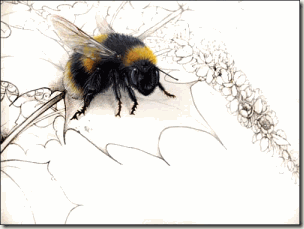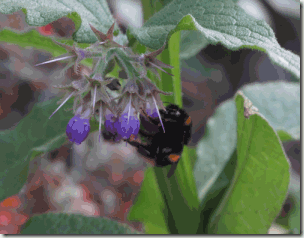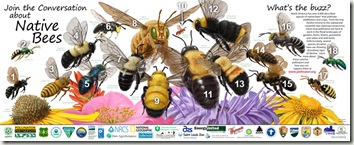First bee sightings
I haven’t really been looking for bees yet but I know from BWARS reports many have been active in the south over this mild winter. On Saturday I saw my first 2014 bumble bees and a honey bee here the garden, along with a big bee mimic hoverfly.
The bumbles were the Buff tailed Bumble Bee, Bombus terrestris and the Early Bumble Bee Bombus pratorum. My bee friendly neighbour has an early clematis and we both have winter honeysuckles and the wild bird cherry is just coming into bloom.
The bees were busy around them all. We were talking today over the fence. “When I saw the bees were back it just made me smile” she said. Me too Carole!
My painting of the big beautiful Bombus terrestris on wonderful bee friendly early Mahonia.
The last bee of 2014 was this Bombus terrestris I photographed on Nov 30th on very late flowering comfrey.
The comfrey is such a star.
It’s so easy? PLANT MORE BEE FRIENDLY FLOWERS!!!
It was very depressing to hear of the discovery of yet more new problems for Bumble Bees last week. It has just made me more determined to redouble my efforts this year to help wild bees and promote their conservation. I am just a small scale gardener and the easiest, most effective and cheapest thing that people like us can do is to plant more bee friendly flowers…and goodness, that is easy enough.
What I am doing…
I am thinking of how I can get people to join me in planting more BFF’s both here in the village and wherever they live. Maybe I will set up something online … but for now here is what I am doing
1 Bee house clean out, repair, reassemble and restock the solitary bee house with new tubes. Maybe build an extra one…Yes!
2 Order some new bee friendly perennials. Lots of online shops, and garden centres now display the helpful RHS pollinator friendly logo.
There are also specialist suppliers. like Bee Happy Plants who I have bought from in the past.
3 Seed checking I am checking my seeds to see what annuals I might need to sow or restock. I save seeds from poppies, phacelia and anything else I can think of that might help. It’s a random business but I end up with lots of seeds which I generally scatter on newly dug bits of the front garden. We are slowly getting rid of the grass out there.
4 Looking to see which flowers and trees the bees are visiting
We garden on very VERY heavy clay and the previous owners did not garden but put down grass. We are digging it up… slowly. I am not used to heavy clay and not all of the lovely bee friendly flowers will grow here. It is the beginning of year three for us here and I am beginning to see which plants are happy and which are not. Thistles absolutely love it..sigh…5 Bee Fostering Collecting boxes for possible Bumble Bee fostering. My bee friendly local pest control guy Mathew brought 4 colonies to me last year. He is very VERY reluctant to move Bumble Bees and tries to persuade people they are benign, but some people just don’t listen. Three made it through to a certain extent. One lucorum, one very successful lapidarius and a huge terrestris colony. It was very rewarding.
Plant Lists For now if you are dithering about some new plants look for the many online resources and suppliers of Bee Friendly Plants. The RHS’ two PDFs Perfect for Pollinators: Garden Plants and Perfect for Pollinators: Wild Flowers are a good start.
Print them off… give them to your friends… pin them up at school, community centre, leisure centre, gardening club…anywhere….everywhere… More bee encouragement to come… Oh and luckily my Tree Following trees, Willows and Horse Chestnuts, are very good for pollinators!!
I also decided my next bee painting will be Bombus Ruderatus the beautiful black version of the Large Garden Bumble Bee which I saw a couple of years ago in Dads garden. I made a sketch at the time but, especially as it is a fairly local species it’s time I made a good study.










